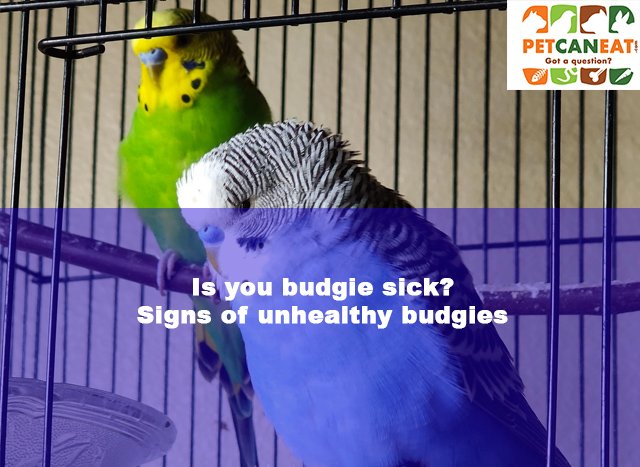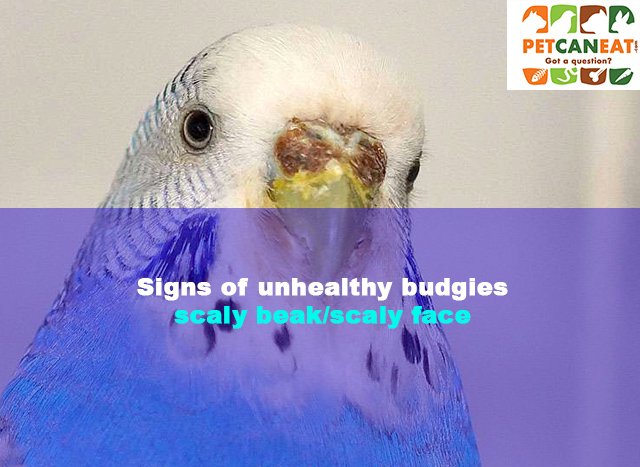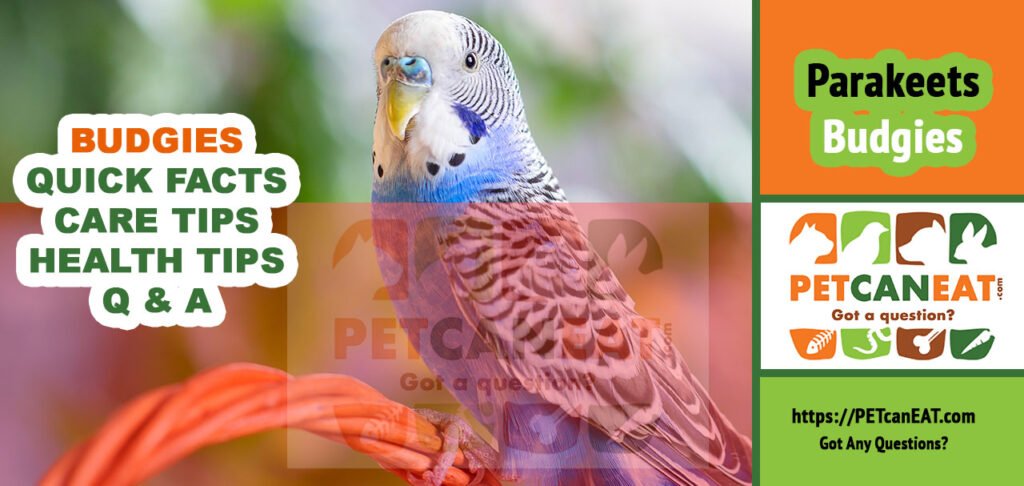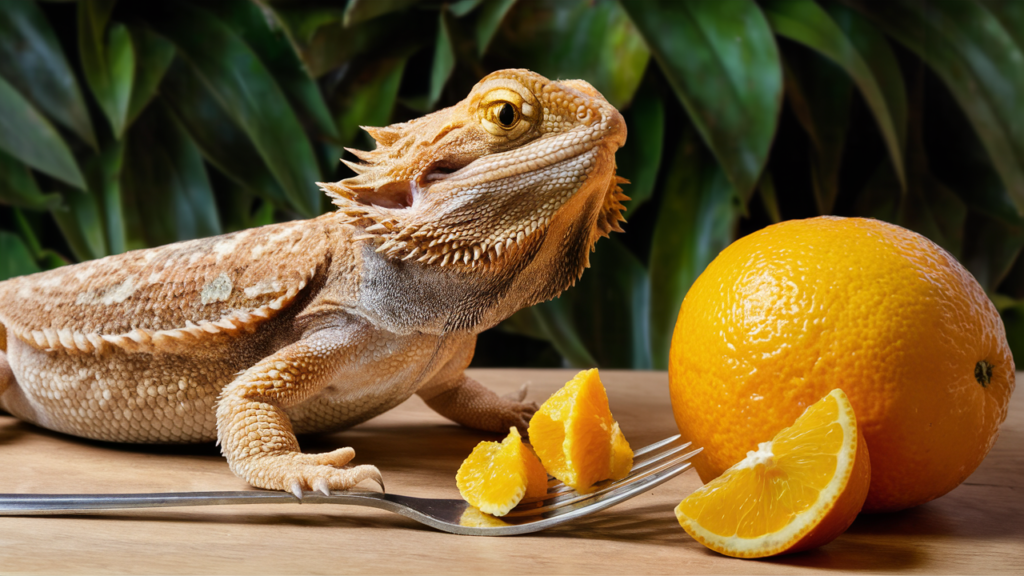Budgie care for beginners – What can I feed my budgie?
Getting an exotic bird such as a budgie may seem like a great idea, and they do make great pets! However, before you buy one, you must make sure that you do some research first and are prepared to commit time, money, and effort into raising a healthy, happy budgie. That’s why we prepared this ultimate quick budgie guide for beginners.
Budgies can live between five to ten years or more, which is a big commitment. Are you going to be around to look after your budgie? Do you have other pets to consider? Can you afford to look after your budgie? Think about everything first, and then you’ll see if you will still be as committed to budgie ownership as you first thought.
Before buying a budgie
Before choosing a budgie as a pet, consider the following:
Budgies need the right size of home.
If your budgie will be living in your house, it will need a big cage designed specifically for a budgie, so it has lots of space to move around with plenty of perches.
They’ll also need to be let out of their cage so they can spread their wings and exercise by flying around properly. You’ll need to be comfortable with having a budgie flying around, and also make sure you close all windows and doors to prevent your budgie from escaping.
Do you have the right amount of space for your budgie’s cage?
Budgies require a varied diet.

You should give your budgie a good quality diet by giving him commercially available food for budgies. This will consist of complete pelleted foods or seeds full of the essential nutrients budgies need. However, you must offer your budgie some fruit and vegetables in small quantities and make sure they have plenty of water.
related:
Can budgies eat cilantro? Find out now!
Budgies can be noisy and messy.
On occasions, your budgie could be pretty noisy when he’s chirping away, but this also means he is happy.
If you let him out of his cage, it’ll be tempting for him to want to chew on certain objects and may even go to the toilet! They can also pick their feathers, which could float outside the cage and onto other bits of furniture in the room.
Keep your budgie away from fumes.
You must make sure you do not smoke, spray aerosol fumes, or light candles/fires anywhere near your budgie. Any form of chemical fumes can harm your budgie and could even kill it.
Budgies take time to be tamed.
It may take time to tame your budgie, so you’ll require some patience. The younger the budgie, the easier it is to train them. This could take several weeks or more, and you should start with small strokes inside his cage and repeat the process until they become comfortable with this. You can then work your way up to eventually handling him outside the cage.
Housing your budgie
Before you buy your budgie, make sure you have the following things:
- Aviary (if housing your budgie outside)
- Cage (large, if housing your budgie inside)
- Cage cover
- Water pot
- Seed pot
- Seeds or pellets and fresh fruit & veg
- Grit
- Perches
- Bird sand or sand sheets
- Toys
Tips on housing your budgie/parakeet
- Budgies will thrive the most if you keep them in an outdoor aviary. However, a large indoor cage with plenty of toys and time to fly around will serve just as well.
- If you are keeping a budgie indoors, make sure the cage you buy is large and designed specifically for a budgie; this way, they’ll have enough space to move around the cage.
- It should also have horizontal bars to allow your budgie to climb.
- A cage wider than its height is the best design, so your budgie can easily hop from perch to perch.
- It would be best to keep the cage in a room with plenty of human contact and safety when they need to fly around outside the cage. They shouldn’t be kept in their cages all day, as they must spread their wings and amuse themselves for a while. So you must let your budgie out of its cage daily to get some much-needed exercise and have some fun.
- Ensure you first shut all windows and doors in the room to prevent your budgie from escaping.
How to bird-proof or budgie-proof your home
In order to ensure the safety of your budgie, it is recommended for the owners to bird-proof the budgie’s surroundings. Here are some tips on how to bird-proof or budgie-proof your home for a thriving, safe budgie/parakeet!
- You should move out any potential hazards such as
- ornaments that could fall,
- electrical cables,
- hanging strings
- household plants, etc.
2. The cage will need to have a water feeder and either a water bowl or enclosed water bath for both the budgie to drink and sometimes to bathe in. You can bathe the budgie yourself, although some prefer their owners to simply spray them with tepid water on them and let them handle their business.
3. You can find enclosed water baths in pet stores – Here’ are some water baths we have hand-picked for you.
4. At night, you may wish to cover your birdcage if it is located in a place that is likely to drop in temperature. This will also encourage your budgie to settle down and sleep for the night.

Tips on Budgie cage furnishings – Budgie enrichment tips
When you furnish the cage, make sure there are perches near both food and water bowls so your budgie can access these easily, with a few perches higher in the cage as budgies like to be high up.
You can use small fruit tree branches as perches — plus they’re free! Giving your budgie perches of different widths is also advised, as this will allow him to alter his grip and prevent his feet from cramping and becoming deformed.
Your budgie will need to be kept occupied and entertained for the duration of his time in the cage, so provide him with toys and fun bits of furniture to prevent him from getting bored — boredom can result in budgies pulling their feathers out!
Here is some toys fun for your budgie to use, but try not to overcrowd the cage:
- Ladders,
- swings,
- bells
- chew toys
You will also need to ensure that the toys don’t end up posing a problem or causing any danger to your budgie — i.e., any loose string from a swing that your budgie could get tangled in. Lots of interaction between you and your budgie, such as talking and handling, is also good for him — budgies will get tamer as time goes on.
How to Clean your budgie’s cage
before you start, place a layer of bird sand or sand sheets at the bottom of your budgie’s cage, which will soak up any water or droppings. You should clean this daily and give a quick wipe over the perches and toys in the cage.
Make sure you thoroughly clean your cage once a month using a pet-friendly disinfectant and keep your budgie away from any cleaning chemicals while you do this.
It’s your job to keep your budgie safe, so before letting your budgie out of its cage, consider the following:
- They like to explore, play, and may nibble on things, so ensure nothing in the room can harm your budgie.
- Make sure no open fire/candle is burning around its sorroundings.
- Check for any poisonous materials in the room, such as plants, other foods (chocolate), metals, glues, and rust! Your budgie will want to nibble it.
- Ceiling fans — turn them off.
- Remove any cats/dogs from the room.
- Remove any buckets or sinks full of water — if your budgie flies into the water, it will drown.
- If in a kitchen, make sure any hot surfaces have cooled (i.e., oven rings; it is not advised that your budgie is allowed access to your kitchen as there are many potential hazards)
- Close all windows and doors.
All you need to know the budgie
A budgie (real name budgerigar, or parakeet) is a small, long-tailed parrot originating from Australia’s wild, drier parts. Over the last five million years, they have survived harsh conditions, and today, they are bred in captivity and have become very popular pets worldwide.
Budgies’ usual colors are green and yellow with black markings on the nape, wings, and back. However, since being bred in captivity, you will also see colors such as:
- whites,
- blues,
- yellows
- grays.
Other reasons budgies have become very popular pets worldwide includes
- Their small size and playful nature. In addition,
- They are relatively easy to look after and are a great company!
- They are also very intelligent and have the ability to mimic human speech.
- Budgies can live between five to ten years; however, there are records of some who live longer than this if they are looked after well and have plenty of exercise and a good diet.
- They are ideal pets for people of all ages and can be suitable for people who live in smaller homes or aren’t allowed a larger pet such as a dog or cat.
- They are naturally flocking creatures and love the company of another budgie, so if you are only choosing to have a budgie on its own, there will need to be lots of interaction between you, your family, and your budgie every day.
Feeding your budgie
What does a budgie eat?
In their natural habitat, budgies would typically eat seeds and leaves from grasses and flowers and nibble on bark and branches to keep their beaks short.
You can give pet budgies commercial small birdseed mixtures, plus some fruit — but not too much as this can cause diarrhea.
What can budgies eat?
It’s safe for budgies, in small amounts, to eat uncooked vegetables such as
- carrot,
- lettuce,
- leafy greens
- strawberries
- cucumber
Avoid watery lettuces such as iceberg and cabbage as these will also cause diarrhea and stick to dark green and purple lettuces, which will be full of nutrients.
You should give fresh fruit and vegetables to your budgie every few days, chopped into small pieces and mixed with their regular food.
Ensure all fresh vegetables are thoroughly washed to avoid harming your budgie with chemicals and pesticides.
You can also give other commercial birdseed treats such as sprouted seeds and millet, and oats are good for during the winter months. You should mix all food with grit, which contains oyster shells, charcoal, ground eggshell, calcium, cuttlebone, and mineralized lime, which helps them digest their food.
Pellets are an alternative to seeds and have the same nutritional balance, similar to budgies in the wild. You will still need to give your budgie fresh fruit and vegetables with pellets to keep their vitamin levels up.
Foods to avoid with your budgie
Some foods are recommended always to avoid giving to your budgies, such as
- fruit seeds,
- avocado,
- tomato leaves and stems,
- rhubarb,
- uncooked beans, and
- sugary foods like chocolate.
Fruit seeds are toxic to birds, so when feeding them fruit, make sure you remove them before feeding them to the — strawberry seeds are OK. You should also avoid any dairy products as budgies cannot digest lactose.
Do you need a Cuttlefish for your budgies?
A cuttlefish bone should be put into the cage for your budgie to peck at — this will give him an important calcium source and keep his beak from becoming overgrown.
A mineral block is also great to put into the cage as this, too, will be something for your budgie to peck at and keep him topped up with all the right nutrients for him to thrive.
Budgies will usually pick at seeds and leave behind the shells, which can pile up on top of any uneaten food below. So cleaning out their food bowl and replacing it with new food throughout the day is essential.
Caring for your budgie
Do budgies like to be handled?
Like most animals — a budgie will need to be slowly introduced to human handling. If you have a young budgie, you will need to leave him for a few days in his new home until he gets used to his new surroundings. At first, start introducing your hand to the budgie — you may get a few nips or none at all.
This will depend on whether the budgie is feeling threatened or not. Once your budgie is comfortable with being near your hand, try gently stroking him and eventually encouraging him to step onto your finger. This process can take several weeks, but if done correctly and regularly (preferably with the same person), you will gain your budgie’s trust, and you should eventually be able to pick him up.
Do budgies bite?
If your budgie is new to the family, he may nip you a few times as he’ll be scared and defending his territory — after all, we are much bigger and scarier to him! He’ll need some time to adjust to a new environment, so the best thing you can do is be patient and slowly build a relationship with your budgie.
He’ll start to get used to your presence, and if you talk quietly to him and approach him slowly, he’ll learn to trust that you won’t harm him. Once you have correctly socialized your bird, the biting should stop — this may take some time and effort to get to this stage, but as long as your budgie doesn’t feel threatened, he won’t bite.
How often do I need to clean my budgie’s cage?
It would be best if you cleaned out the bottom of the budgie’s cage, which should be cleaned out daily.
Sweep away any droppings and stale food. Any food pots should also be emptied, cleaned, and refilled daily.
You should give the rest of the cage, including any perches, toys, and other fittings, a wipe over every few days, with a thorough clean of everything once a month. This should keep the environment clean and healthy for your budgie.
Will my budgie fly away?
Since you have purchased a proper cage designed for a budgie, he shouldn’t escape or fly away. You’ll need to be more alert when you let your budgie out of his cage, as he’ll want to explore, but you won’t want to lose him! So ensure all the windows and doors are closed so he can’t fly away. He’ll enjoy being able to fly around and exercise, so his room must be adequate for him to do this.
Can two budgies live together?
Budgies are okay with living independently (provided they have lots of interaction with their owners) but tend to prefer the company of another budgie. If they live in a cage, then a pair of budgies would be most suitable, and both males and females can live together.
To avoid mating, you may want to get two of the same sex. If you choose to keep your budgie on his own, then ensure you give him plenty of attention to keep him happy.

Is your budgie healthy?
If your budgie is kept in a clean, dry home and fed well, he should remain healthy throughout his life. However, if he does become ill, things can deteriorate rapidly. Once you know your budgie well, you’ll soon notice if his health starts to deteriorate.
Make sure you maintain a well-balanced diet, keep plenty of toys in the cage, clean water bottles and food bowls daily, keep his nails clipped, and ensure he has regular exercise outside of his cage.
Signs of an unhealthy budgie:
- Lack of energy or change in demeanor
- Loss of appetite
- Drinking more or less than usual
- Loss of feathers
- Overgrown beak
- Watery eye or nostrils
- Fluffy feathers
- Limping
- Swellings
- Bleeding
- Change in breathing pattern.
If you notice anything different from the normal pattern in any aspect of his health, these may be telltale signs that something isn’t right with your budgie. Any change in appearance, such as
- lumps,
- loss of feathers (outside of malting season),
- a crusty cere (above the beak),
- irregular breathing,
- discharge around the eye,
- even a change in their demeanor can tell you that your budgie isn’t well.
Scaly Beak or Scaly Face
A common condition in budgies is Scaly Beak or Scaly Face — which is contagious and requires treatment immediately by a vet.

what are the symptoms of Scaly Beak or Scaly Face
Signs include crustiness of the beak, face, cere, and sometimes the legs and feet.
Do regular checks to ensure no signs of this on your budgie. Seek advice if you ever become concerned about your budgie’s health.
Claws will need to be trimmed repeatedly, which isn’t a pleasant process for the budgie, so a vet should do this. Perches with a slightly rougher texture can help keep the claws trim.
Another crucial thing to note is that budgies have susceptible respiratory systems, so you must not expose your budgie to any fumes from aerosols such as:
- air fresheners,
- cleaners,
- hair spray,
- deodorant,
- perfumes,
- cigarette smoke,
- open fires and candles.
These fumes are extremely bad for their health and could result in death.
Zinc poisoning
Zinc poisoning is common in birds as they tend to chew most things, including wire cages coated in zinc. This process is called galvanization, a treatment used on steel or iron to prevent rust. You must safeguard your budgie and research how to spot zinc poisoning.
Zinc poisoning can cause problems with the liver, kidneys, and pancreas and even cause death.






